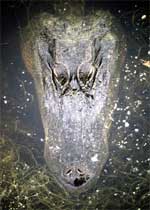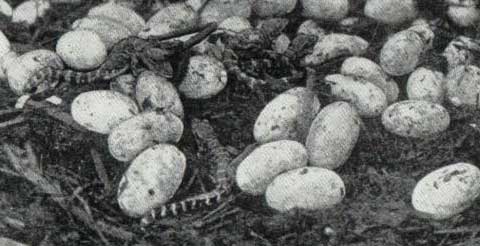|

 Alligators vs. Crocodiles: Alligators are characterized by a broader snout and eyes more dorsally located than their crocodile cousins. Both living species also tend to be darker in color, often nearly black (although the Chinese alligator has some light patterning.) Also, in alligators only the upper teeth can be seen with the jaws closed (in contrast to true crocodiles, in which upper and lower teeth can be seen), though many individuals bear jaw deformities which complicate this means of identification. Alligators vs. Crocodiles: Alligators are characterized by a broader snout and eyes more dorsally located than their crocodile cousins. Both living species also tend to be darker in color, often nearly black (although the Chinese alligator has some light patterning.) Also, in alligators only the upper teeth can be seen with the jaws closed (in contrast to true crocodiles, in which upper and lower teeth can be seen), though many individuals bear jaw deformities which complicate this means of identification.
Eyes that Glow Red: The eyes of an alligator glow red when a light is shined on them. This fact can be used to find alligators in the dark.
Big and Beautiful: According to the Everglades National Park website, the largest alligator ever recorded in Florida was 17 feet 5 inches long (5.3 meters). The largest alligator ever recorded measured 19 feet 2 inches (5.8 meters) and was found on Marsh Island, Louisiana.

Where in the World? There are only two countries on earth that have alligators: the United States and China. The Chinese alligator is endangered and lives only in the Yangtze River valley. The American Alligator is found in the United States from the Carolinas to Florida and along the Gulf Coast. The majority of American Alligators inhabit Florida and Louisiana. In Florida alone there are an estimated more than 1 million alligators. The United States is the only nation on earth to have both alligators and crocodiles. American Alligators live in freshwater environments, such as ponds, marshes, wetlands, rivers, and swamps. In China, they live only along the fresh water of the Yangtze River.

Solitary Creatures: Alligators are solitary, territorial animals. The largest of the species (both males and females), will defend prime territory; smaller alligators have a higher tolerance of other alligators within a similar size class.
Fast Eaters: Although alligators have heavy bodies and slow metabolisms, they are capable of short bursts of speed that can exceed 30 miles per hour. Alligators' main prey are smaller animals that they can kill and eat with a single bite. Alligators may kill larger prey by grabbing it and dragging it in the water to drown. Alligators consume food that cannot be eaten in one bite by allowing it to rot or by biting and then spinning or convulsing wildly until bite size pieces are torn off. This is referred to as the "death roll."
On the Menu: Alligators are opportunistic feeders, eating almost anything they can catch. When they are young they eat fish, insects, snails, and crustaceans. As they grow they take progressively larger prey items, including: larger fish such as gar, turtles, various mammals, birds, and other reptiles. They will even consume carrion if they are sufficiently hungry. Adult alligators can take razorbacks and deer and are well known to kill and eat smaller alligators. In some cases, larger alligators have been  known to hunt the Florida panther and bears, making it the apex predator throughout its distribution. As humans encroach onto to their habitat, attacks on humans are not unknown, but are few and far between. known to hunt the Florida panther and bears, making it the apex predator throughout its distribution. As humans encroach onto to their habitat, attacks on humans are not unknown, but are few and far between.
Don't Get Too Close: Unfortunately deaths by alligators have increased. There have been only 9 fatal attacks in the U.S.A throughout the 70's, 80's and 90's. 11 people were killed by alligators between 2001 and 2006; more deaths have occurred in the past 5 years than in the previous 30. For a long time people have been taught that alligators fear humans, which is true, but lead some people to be more courageous and enter the animal's habitat.

Single Mothers: Alligators are seasonal breeders. The mating season is in spring when the water warms. The female builds a nest of vegetation that rots, incubating the eggs. The mother will defend the nest from predators and will assist the babies to water once they hatch. She will provide protection to the young for about a year if they remain in the area.

All text is available under the terms
of the GNU Free Documentation License
|